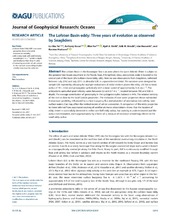| dc.contributor.author | Yu, Lusha | |
| dc.contributor.author | Bosse, Anthony | |
| dc.contributor.author | Fer, Ilker | |
| dc.contributor.author | Orvik, Kjell Arild | |
| dc.contributor.author | Bruvik, Erik Magnus | |
| dc.contributor.author | Hessevik, Idar | |
| dc.contributor.author | Kvalsund, Karsten | |
| dc.date.accessioned | 2018-08-07T12:29:14Z | |
| dc.date.available | 2018-08-07T12:29:14Z | |
| dc.date.issued | 2017-08 | |
| dc.Published | Yu, Bosse A, Fer I, Orvik KAO, Bruvik EM, Hessevik I, Kvalsund K. The Lofoten Basin Eddy: three years of evolution as observed by Seagliders. Journal of Geophysical Research - Oceans. 2017;122(8):6814-6834 | eng |
| dc.identifier.issn | 2169-9291 | en_US |
| dc.identifier.issn | 2169-9275 | en_US |
| dc.identifier.uri | https://hdl.handle.net/1956/18020 | |
| dc.description.abstract | The Lofoten Basin in the Norwegian Sea is an area where the warm Atlantic Water is subject to the greatest heat losses anywhere in the Nordic Seas. A long-lived, deep, anticyclonic eddy is located in the central part of the basin (the Lofoten Basin Eddy, LBE). Here we use observations from Seagliders, collected between July 2012 and July 2015, to describe LBE in unprecedented detail. The missions were designed to sample LBE repeatedly, allowing for multiple realizations of radial sections across the eddy. LBE has a mean radius of 1864 km and propagates cyclonically with a mean speed of approximately 3–4 cm s21. The anticyclonic azimuthal peak velocity varies between 0.5 and 0.7 m s21, located between 700 and 900 m depth. The average contribution of geostrophy in the cyclogeostrophic balance is 44%. The relative vorticity of the core is close to the local Coriolis parameter. The evolution of core water properties shows substantial interannual variability, influenced by surface buoyancy flux and advection of anomalous low-salinity nearsurface waters that may affect the vertical extent of winter convection. A comparison of the eddy properties to those inferred from automated tracking of satellite altimeter observations shows that the location of eddy center is successfully detected to within one half eddy radius, but vorticity is underestimated and the radius overestimated, each approximately by a factor of 2, because of excessive smoothing relative to the small eddy radius. | en_US |
| dc.language.iso | eng | eng |
| dc.publisher | American Geophysical Union | en_US |
| dc.rights | Attribution CC BY-NC-ND | eng |
| dc.rights.uri | http://creativecommons.org/licenses/by-nc-nd/4.0/ | eng |
| dc.title | The Lofoten Basin Eddy: three years of evolution as observed by Seagliders | en_US |
| dc.type | Peer reviewed | |
| dc.type | Journal article | |
| dc.date.updated | 2018-03-06T12:30:21Z | |
| dc.description.version | publishedVersion | en_US |
| dc.rights.holder | Copyright 2017 The Author(s) | en_US |
| dc.identifier.doi | https://doi.org/10.1002/2017jc012982 | |
| dc.identifier.cristin | 1486962 | |
| dc.source.journal | Journal of Geophysical Research - Oceans | |
| dc.relation.project | Norges forskningsråd: 250784 | |
| dc.subject.nsi | VDP::Matematikk og naturvitenskap: 400::Geofag: 450::Oseanografi: 452 | |
| dc.subject.nsi | VDP::Mathematics and natural scienses: 400::Geosciences: 450::Oceanography: 452 | |

